Meeting Recap: Bvlgari Masterpieces: Chiming Watches with Fabrizio Buonamassa
Fabrizio Buonamassa, Bvlgari Product Creation Executive Director of Timepieces (Neuchâtel, Switzerland)
January 10, 2022
Video recordings of lectures are available to members immediately (using your membership password), and to the general public with a two-month delay.
For the first lecture of 2022, Fabrizio Buonamassa, Product Creation Executive Director of Timepieces for Bvlgari, discussed the brand’s chiming timepieces with the Horological Society of New York (HSNY).
One of the unique historical aspects of Bvlgari is its roots in Rome, Italy. It was founded by Sotirios Bulgari in 1884, who began his career as a silversmith and eventually turned to jewelry making. The timepieces came to fruition around 1937 with the Serpenti line and over the years the Bvlgari brand has expanded to include watches, perfume, accessories, hotels and resorts.
For the production of timepieces, Bvlgari has two manufacturers in Switzerland: the Le Sentier manufacturer which produces the movements, and the Saignelégier manufacturer which manages the cases, bracelets and dials. One of the distinctive aspects of Bvlgari is that the same watchmaker oversees the entire process of building the timepieces. That includes the development process and the start-to-finish assembly process. The development of chiming watches is an exceptionally lengthy process. The duration can take four to five years in development alone and up to eight months to find the right shape of the hammers for the repeater.
Regarding chiming timepieces, the Octo Finissimo Minute Repeater is known for its thinness. The goal was to augment the sound since the hammers and gongs are exceedingly small. The fissures in the dial are made possible by the openings of the number 12 and the indices. That specific layout with the openings created the best sound quality. While designing the piece, Buonamassa wanted to use titanium, but the feedback was to use a material that was familiar such as white gold, rose gold or platinum. He knew that the aesthetic needed to be in titanium with grey, with sandblasted finishing for the bracelet, case and dial. Based on the positive reception the timepiece received during the Basel Fair, his decision proved justified.
Finally, the audience saw the creativity of Buonamassa when he started to sketch components live to illustrate the workings of sound quality in the Minute Repeater since varied materials produce different sounds.
HSNY thanks Fabrizio Buonamassa for his fascinating lecture!
Submitted by Melody Benloss, Recording Secretary

